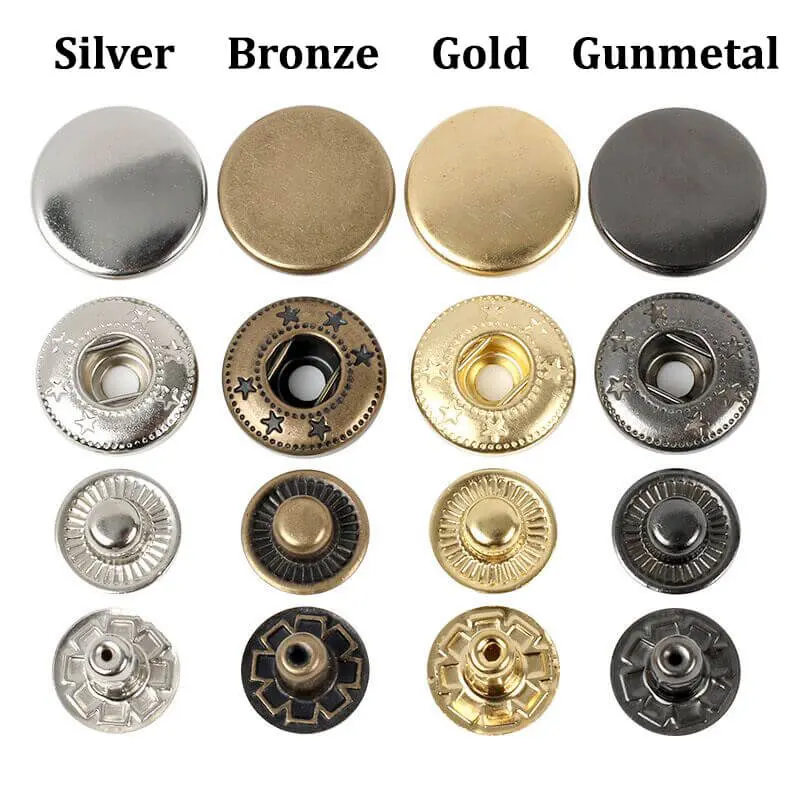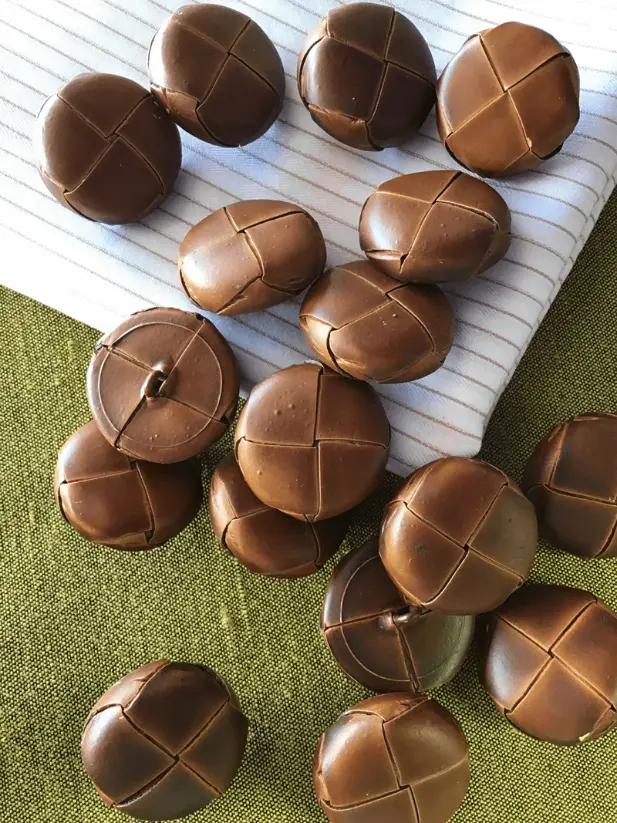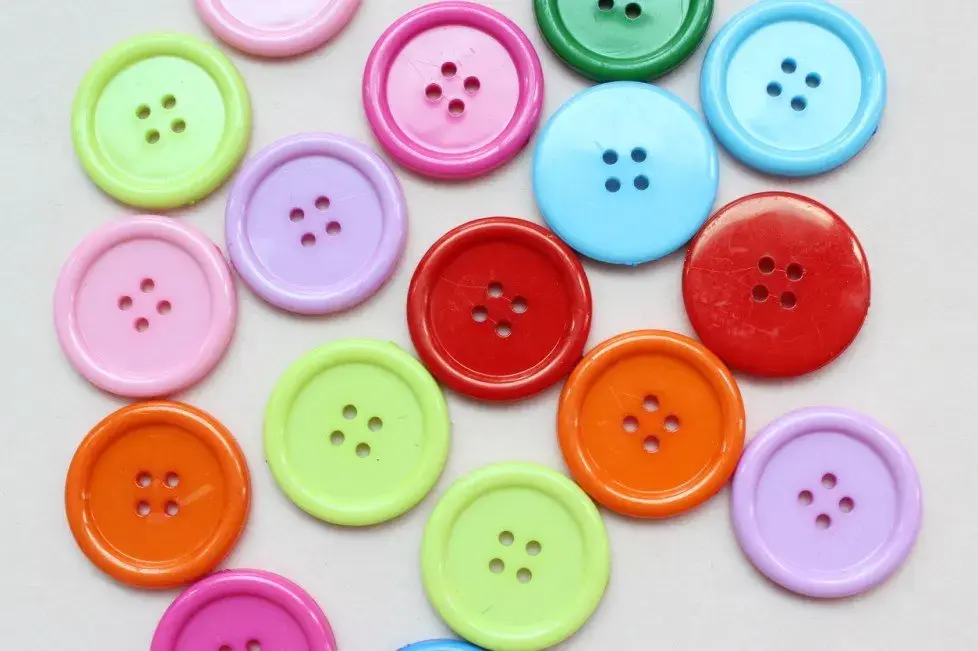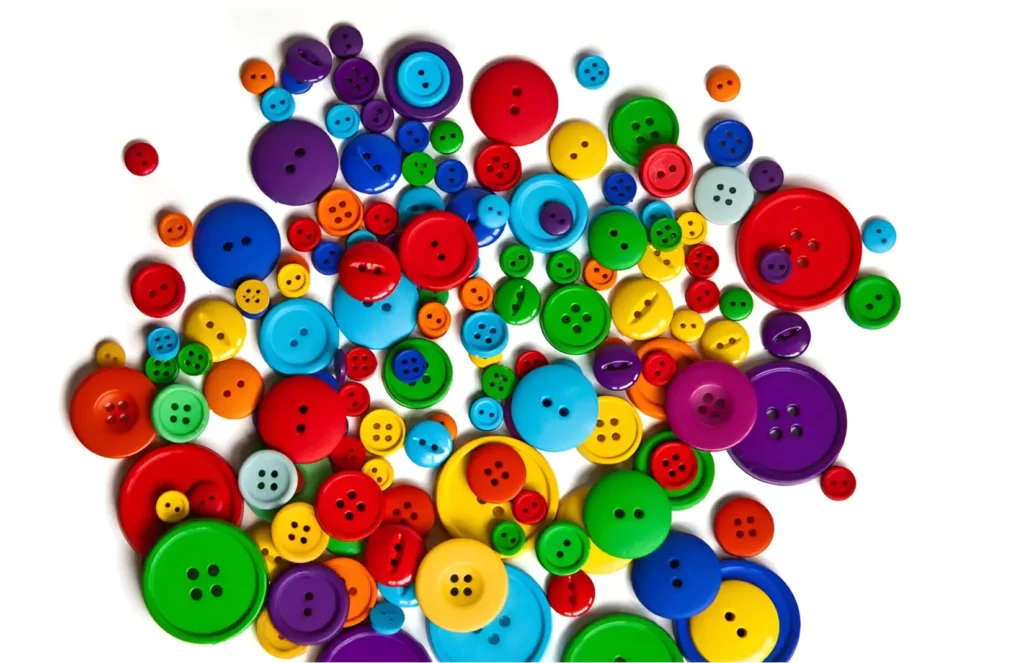You cannot overstate the importance of details in the constantly changing world of clothing design. The modest button is one such element that can completely change the look of a piece of clothing. As the fashion industry continues to embrace individuality and innovation, designers are exploring various types of buttons that go beyond the conventional.
This exploration adds a touch of uniqueness to garments and elevates the wearer’s experience. So, in this article, we’ll discuss different types of buttons and their usage, along with some other information that you might find helpful.
13 Different Types of Buttons
Different kinds of buttons have developed over time, each with a distinct function and impacting the overall apparel style. The following are some of the most popular types of buttons:
1. Shank Buttons
Shank buttons have a classic beauty and are distinguished by a loop on the rear. Thanks to their design, you may easily sew them onto fabrics and don’t require buttonholes!

Shank buttons, often associated with formal attire, lend an air of refinement to dresses, blouses, and coats. However, these buttons come in various sizes, shapes, and embellishments and can be decorative or functional.
2. Traditional Sewing Buttons
With their adaptability and practicality, traditional sewing buttons form the foundation of button design. In addition to being flat, concave, or domed, they can be square, rectangular, or spherical.

Natural elements like wood or horn are among the materials available, in addition to plastic and metal. Moreover, customization based on the design and purpose of the garment is possible with two or four stitching holes, each with a different size.
3. Snap Buttons
Snap buttons comprise two interlocking discs that snap together when pressed. People also refer to them as press studs or poppers. These buttons are familiar in casual clothing because they offer a simple and quick way to close garments.

Snap buttons come in plastic and metal, enabling versatility in design and longevity. You can frequently use these as fasteners for cuffs, pockets, and other valuable parts of apparel.
4. Stud Buttons
Like snap buttons, stud buttons have two components that click together when pressed. Due to their convenience, you can frequently see these buttons in casual clothing items such as overalls and denim jackets.

They lend a sense of rugged appeal to the overall look and are excellent for clothing that needs a secure closure due to their durable design.
5. Toggle Buttons
The distinguishing features of toggle buttons are a loop and a bar. The bar is threaded through the loop fastened to one side of the garment to secure the button. This style, which has a rustic or nautical feel, is popular in outerwear like coats and jackets.

Toggle buttons come in various sizes and materials, which adds to their artistic potential.
6. Covered Buttons
A classy alternative is covered buttons, which have the button hidden under a cloth covering. There are countless design options when choosing whether to use a contrasting or the same fabric for this covering as the garment.

Individuals frequently utilize covered buttons in formal and couture apparel to create a smooth and refined look.
7. Fabric-Covered Buttons
Buttons covered in the fabric give clothing a sophisticated touch. They have a cloth covering over the button, just as covered buttons. But behind the covering, these buttons feature a soft cloth or padding that gives them a plush, opulent appearance.

You can frequently find these buttons wrapped with fabric on delicate clothing items, such as lingerie and formal attire.
8. Wooden Buttons
Wooden buttons introduce an eco-friendly and natural element to garments. They can be simple and unadorned or carved with intricate patterns, catering to various design preferences.

Wooden buttons are often used in bohemian or casual styles, bringing an earthy and warm touch to the clothing.
9. Metal Buttons
Because metal buttons are available in various sizes, shapes, and finishes, you can use them with various outfit styles. They might have simple or complex designs with textures, patterns, or logos.

However, the durability and sophisticated touch of metal buttons improve the aesthetics of both formal and casual wear.
10. Leather Buttons
Leather buttons add a tactile and durable touch to garments. You might find embossed logos or patterns on them, or they can be simple and functional. An air of toughness and durability is imparted to casual apparel such as trousers and jackets by the ubiquitous presence of leather buttons.

11. Horn Buttons
Horn buttons have a distinctive and organic appearance since manufacturers make these from animal horns. These buttons can have intricately carved buttons with etched patterns or plain, crude designs.

We frequently utilize horn buttons in traditional and vintage-inspired clothing to create an authentic and character-rich look.
12. Pearl Buttons
Manufacturers often craft pearl buttons from mother-of-pearl or imitation pearl materials, featuring a smooth, iridescent surface. Individuals used precious pearl buttons in formal attire for centuries.

However, modern versions are easily obtained and frequently seen on blouses, cardigans, and other feminine apparel pieces, lending a touch of refinement to the overall style.
13. Plastic Buttons
Plastic buttons come in various colours and designs, are lightweight, and are cheap. They are appropriate for a broad range of fashion designs because, despite their simplicity, it is possible to turn them into many shapes.

Manufacturers widely use plastic buttons in everyday apparel, such as children’s wear, casual shirts, and pants. They are adaptable. They are famous for garment fasteners because of their adjustability and price.
How to Choose the Right Button for Your Cloth
Selecting the right buttons for your clothing may seem like a minor detail. However, it is essential in improving your garment’s overall aesthetic, functionality, and durability. The right choice can elevate the design, complement the fabric, and increase the garment’s longevity. Here’s a guide on how to choose the right buttons for your clothes:
Consider the Fabric
Choosing the appropriate buttons depends on the fabric you are working with. Select light-coloured, tiny buttons for delicate, airy fabrics like silk or chiffon to prevent overpowering the material.
However, bulkier and more substantial buttons don’t damage heavier materials like wool or denim. Also, consider the drape and texture of the fabric; smooth buttons work well with silky fabrics, whereas textured or elaborate buttons work well with heavier, textured materials.
Style of the Garment
Picking buttons should be based on the style of your outfit. Classy and traditional button choices, such as pearl or covered buttons, go well with formal and sophisticated apparel.
Relaxed button alternatives, such as wooden or plastic, may be appropriate for casual and everyday usage. Ensure the buttons complement the clothing style, and watch the overall design style.
Purpose & Functionality
Ascertain the purpose of each button on your clothing item. You must consider strong choices like metal, plastic, or reinforced fabric-covered buttons if you want to use the buttons primarily for fastening and must endure regular use. You have more options when selecting buttons with distinctive patterns, forms, and materials for aesthetic purposes.
Moreover, it is a must to choose a button depending on where you are using it, such as pants, shirt, cardigan, pockets, etc.
Size & Proportion
The buttons’ size and shape must complement the overall appearance of the clothing. While smaller buttons have a more delicate and understated appearance, larger buttons can make a dramatic statement.
Think about the button location and spacing. While asymmetrical button placement might produce a more dynamic and distinctive design, uniformly spaced buttons may provide a balanced appearance.
Colour Coordination
Harmonize the button color with the fabric or create a striking contrast depending on your design goals. Matching the button color to the fabric provides a cohesive and refined look.
Conversely, you can use contrast strategically to draw attention to specific details or create visual interest. Remember, it is necessary to consider the color of the stitching and other embellishments on your garment to ensure a cohesive color palette.
Personal Style & Preferences
When selecting buttons, take your preferences and style into account. Your taste and uniqueness may come through in the buttons you choose.
Choose buttons with clear, uncomplicated designs if you like a traditional, timeless style. However, for those who like to play around with fashion, experiment with different forms, fabrics, and accessories to give your outfit a distinctive look.
Buttonholes & Fastening Method
The kind of button and the fastening technique affect the selection of buttons. Consider whether there are two or four holes when sewing conventional buttons, and ensure they line up with the buttonholes on your clothing.
While snap or stud buttons provide a quick and straightforward closure, shank buttons work well with heavier fabrics. Furthermore, toggle buttons are an excellent option for outerwear; covered buttons give an elegant appearance.
Care & Maintenance
Consider how the garment will be maintained and cared for when choosing buttons. Certain materials, like plastic and metal, are more wear-resistant and carefree, making them appropriate for daily use.
However, you might need to handle delicate buttons cautiously, including those crafted from organic materials like wood or horn. Saving them for special events or clothes that don’t get as much use is a good idea.
Why Is It Necessary to Choose the Right Button for Your Clothes?
Choosing the right buttons for your clothes is a crucial aspect of garment design that goes beyond mere aesthetics. The selection of buttons plays a significant role in determining the garment’s functionality, durability, and overall appeal. The following are a few of the reasons it is necessary to choose the right buttons for your clothes:
Aesthetic Enhancement
Firstly, buttons play a significant role in a garment’s aesthetic attractiveness. Making the appropriate decision can improve the overall look by enhancing the fabric, design, and style.
The aesthetic harmony you can generate with well-chosen buttons can enhance the visual appeal of a garment. It is regardless of whether you wear formal clothes with traditional, unobtrusive buttons or casual wear with unusual, decorative buttons.
Functionality
Buttons are closures to secure the garment and provide easy wear. Choosing the right buttons ensures that the garment functions as intended.
Consider the size, weight, and fastening method of the buttons based on the fabric and design of the clothing. Properly matched buttons and buttonholes contribute to the garment’s structural integrity, preventing unintended openings and ensuring a secure fit.
Durability & Longevity
The buttons’ resilience directly impacts the garment’s lifespan as a whole. Different materials provide varying degrees of resistance to deterioration.
Choosing sturdy materials, such as metal or reinforced plastic, for everyday clothing worn frequently is a good idea. It can make you confident that the buttons will withstand wear and tear and help the garment endure longer.
Style & Individuality
Buttons are a distinctive element that allows individuals to express their style and personality. The right buttons can add a unique flair to the garment, reflecting the wearer’s taste and preferences.
Whether it’s classic elegance, contemporary chic, or eclectic and bohemian, the choice of buttons is a subtle yet powerful means of showcasing individuality in fashion.
Comfort & Practicality
When choosing buttons, considering the garment’s purpose and the wearer’s comfort is paramount. For everyday wear, opt for buttons that are easy to fasten and unfasten, such as snap or traditional sewing buttons. Shank buttons may be more suitable for thicker fabrics, ensuring functionality and comfort in the garment’s daily use.
So, selecting the appropriate buttons for your clothing is crucial for achieving a harmonic balance between design, utility, and comfort. The thoughtful choice of buttons improves the garment’s entire wearing experience, durability, structural integrity, and aesthetic appeal.
The correct buttons are a small but significant element that transforms a piece of clothing from a thought-out, well-made article, whether for a formal ensemble, casual wear, or a personal fashion statement.
Conclusion
The types of buttons currently trending in apparel design represent a fusion of tradition and innovation. It allows designers to push boundaries and consumers to make unique style statements. As mentioned earlier, although buttons may seem like small and simple components, they play a vital role in the functionality and aesthetics of clothing.
So, if you are looking for a manufacturer that will pay close attention to detail and make your clothing items as per your demand, contact MGOO Fashion. You won’t be disappointed with our service. Thanks for reading through. Have a fantastic day!

